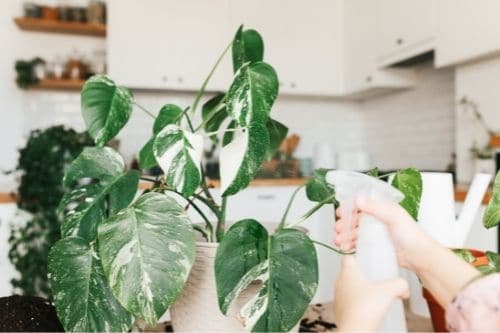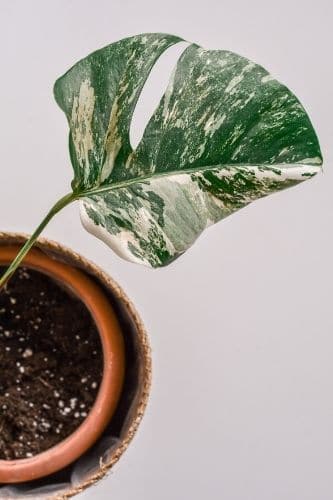If you have a variegated Monstera, you probably spend a lot of time tending to it and trying to make sure it has everything it needs to stay happy and healthy. However, plants develop problems even when we do our utmost to look after them, and if your Monstera is developing brown patches on its leaves, you might be very concerned.
Many different things can cause the leaves of a variegated Monstera to turn brown or develop brown flecks, including too much sunlight, too much or too little water, a buildup of salts in the soil, or stress from being repotted. In some cases, too much fertilizer could cause brown spots on the leaves, and a very dry environment could also be an issue.
Why Is My Variegated Monstera Turning Brown?

As you will have noticed, many things can cause brown leaves on a Monstera, so let’s explore these issues, and look at how to resolve them. You will need to check for each of these by turn to determine what is upsetting your Monstera.
Too Much Sunlight
One of the commonest issues that can cause brown spots on the leaves is too much sunlight. This can be tricky because variegated Monsteras do need a lot of sunlight to thrive. They do not have as much chlorophyll as normal Monsteras, and therefore they must have plenty of light so that they can photosynthesize effectively, or they will die.
However, if your plant gets excessive sunlight, its leaves will start to burn. This will often happen at the edges of the leaves or any parts that are particularly close to the sun. They may blister and curl.
If the brown spots mostly seem to be on the side of the plant that faces the sun, it is likely that your Monstera is getting too much light.
How To Fix It
You’ll need to slightly reduce the amount of light your plant gets. You can do this by relocating the plant to a dimmer spot, or by putting up a thin curtain. However, make sure you aren’t cutting off too much light, or your plant will struggle to grow.
Remember to account for different seasons, too. If your Monstera is only struggling in the summer, remove the curtain or put the plant closer to the window during the colder seasons so it doesn’t suffer from lack of light.
Too Much Water

Over-watering your plant will often lead to brown spots on the leaves because if the soil is sodden, the plant’s roots will start to die. This will cause stress and nutrient deficiencies and will stop your plant from maintaining healthy foliage.
Watering imbalances frequently cause blemishes on the leaves, so check this as soon as you notice the brown spots appearing. The sooner you catch root rot, the greater your plant’s chances of recovery will be.
How To Fix It
You can avoid root rot by making sure that the surface of the plant’s soil has dried out before you give it more water. Push your finger an inch into the soil, and only water the plant if the soil feels dry.
If your plant is too wet already, assess how bad you think the situation is. If you think the pot will soon dry out, put it somewhere warm (not hot), and make sure the surface soil is dry before you give it more water.
However, if the soil is really wet and you are concerned about root rot, you will need to repot the Monstera. Take it out of its pot and rinse off the old soil, and then let the roots dry out for a few hours before you put it in fresh soil.
Make sure it has really good drainage in the new pot; this will help to reduce the risk of root rot in the future.
You should also make sure you aren’t leaving your Monstera standing in water for long periods. If you have it standing on a tray or saucer, empty this a few minutes after watering the plant so that its soil can start to dry out.
Too Little Water
Like too much water, too little water will cause brown leaf spots on your variegated Monstera. Your plant cannot access nutrients without water, and without nutrients, it cannot maintain healthy foliage.
The white parts of the leaves may suffer first, as these tend to be weaker than the green parts. You may also notice the foliage growing limp and floppy if it isn’t getting enough water.
Although Monsteras do not like to be left standing in water, they are rainforest plants, and getting really dry will kill them quite quickly, so make sure you pay attention to your plant’s watering needs.
How To Fix It
You can fix under-watering fairly easily by giving your plant a good drink. Make sure that water is running out of the bottom of the pot to ensure that the soil is getting properly soaked.
If the water seems to be running off, rather than being absorbed into the soil, you should stand the pot in a bucket of water for about ten minutes. This will give the soil time to soak up the water and should make it easier to water in the future.
After ten minutes, remove the Monstera and let it drain. You may also want to check whether the soil has got very compacted; if it has, you might need to repot your Monstera, as they prefer loose, airy soil.
Salt Buildup

If you water your Monstera using tap water, you may find that salts start to build up in the plant’s soil. Tap water has a lot of nutrients in it, and this isn’t always great for the plant.
You might see white crystals forming on the surface of the soil, and this is an indication that there is too much salt in the soil. Salt will burn the plant’s roots and prevent it from taking up nutrients properly.
Tap water also contains limescale in some areas, and this is bad for your Monstera too. The chalk will similarly build up in the soil, clogging the plant’s roots and making it difficult for it to absorb nutrients or water.
Both of these issues can cause brown spots to appear on your Monstera’s leaves, especially the white parts.
How To Fix It
If your Monstera is suffering because of salt or limescale, you will need to flush its container out with rainwater or filtered water. The easiest way to do this is to move the plant outside during a rainstorm and wait for the rain to do the job for you.
However, if this isn’t practical or your area is too cold to have a Monstera outside, lift the plant into a bath, sink, or the bottom of a shower, and collect some rainwater, or purchase some filtered water.
You can then use this to wash the pot out thoroughly. Keep rinsing to wash the salt and limescale through the soil and out of the bottom of the pot.
Allow the Monstera to drain, and then put it back in its usual position and see if it improves. Try to water it with rainwater going forward to prevent this from happening again.
Repotting Stress
Sometimes, you might see your variegated Monstera developing brown spots on its leaves after you have repotted it. This can be alarming because it suggests that you haven’t got the right drainage for the plant, but it isn’t necessarily something you need to worry about.
Being repotted can stress a plant out, and sometimes, your plant will develop brown spots simply due to stress. That doesn’t mean you should ignore other possibilities, but be aware that a variegated Monstera is a little fragile, and it may not like having its roots handled.
How To Fix It
There isn’t much you can do to fix the stress caused by repotting. It is a good idea to repot your Monstera only when it needs it, which should be fairly infrequently since variegated Monsteras are slow-growing.
You can also mitigate the stress by making sure the rest of your plant’s environment is low stress. Provide it with sufficient amounts of light, fertilizer, and humidity, and make sure it is kept in reasonably stable temperatures.
This should help it to recover from the stress and resume its normal growth reasonably quickly.
A Dry Environment
Monsteras are rainforest plants, and if the edges of your Monstera’s leaves are turning brown and crispy, this may indicate that the air is too dry. Although most Monsteras will cope with a slightly dry environment, they prefer humidity levels between 60 and 80 percent – which is much damper than the average home.
If your plant is consistently too dry, its leaves may lose their glossy sheen, and eventually might start to develop brown edges.
How To Fix It

You should be able to solve this problem by humidifying the plant.
You can stand your Monstera in your bathroom while you shower, or use a plug-in humidifier, like the one in the picture above, to boost the moisture in the air around it. You can easily buy a humidifier with the settings you prefer on Amazon that matches the decoration of your house.
Should You Cut Off Brown Spots?
It should be okay to remove brown spots from your Monstera plant, although it is probably best to do this only if they are at the edges of leaves, rather than in the centers. Use sterilized shears and simply trim away the brown.
This part of the leaf is dead, so removing it shouldn’t harm the plant at all, and may encourage it to focus on new growth. It will also make the plant look better.
Why Do The White Leaves Turn Brown?
You might be wondering why the white parts of the leaf seem more susceptible to browning than the green parts. The answer is that the white parts are not as strong because the chloroplasts are defective, and they cannot produce chlorophyll or photosynthesize as the green leaves can.
This means they are weaker and age more quickly than the green leaves (or those that are predominantly green). Problems are more likely to show in the white areas first, although they will likely spread to the green areas if you don’t resolve them fairly quickly.
Conclusion
A variegated Monstera turns brown when there is a problem with the environment it is being kept in. You will need to check for issues like watering, sun damage, soil problems, stress, and humidity, and correct whatever problems you find. Next, trim off the brown foliage and hopefully, your plant will recover!
